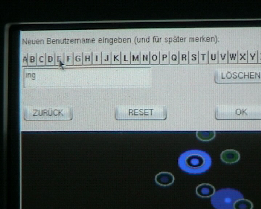AI Arena (2004)
An interactive artificial life simulationby Hans H. Diebner, Rudi Hinterwaldner, Florian Grond

|

|
 Hans H. Diebner, Rudi Hinterwaldner, Florian Grond: AI Arena. ZKM Media Museum Karlsruhe 2004. |
In order to survive and to replicate by cleavage the virtual beings have to haunt randomly distributed food sources of two types. These sources create attractive potentials in form of a logistic function that depend on their filling level as well as on the internal saturation state of the creatures. The two source types oblige the agents to locomotion, i.e., prevent them from persisting at one source which would be the case if the source is faster replenished than the agents dissipate.
In a first prototype which is to be upgraded according to the gathered experience, the strategy specifies a relatively simple behavioral pattern with respect to other agents. A cooperative strategy means that the agent gives advantage to other agents with lower saturation state. Even though the survival of the individual agent may be at higher risk, the probability to ensure the survival of the species may increase. However, a mixture of many species with different strategies disables an analytic proof of what really will happen, in particular if the degree of cooperation is continuously adjustable. The first prototype is endowed with only 6 different strategies. Nevertheless, because of the continuously adjustable parameters the complexity is pretty high so that one casually encounters surprises.
Hans H. Diebner, Rudi Hinterwaldner and Florian Grond: AI Arena.
Video documentation with excerpts from ZKM Media Museum Karlsruhe 2004.
The usual considerations of such systems leave the suspicion that to some degree the result is already inserted into the design of the problem. One often meets disabusing or almost missionary motivations in designing cooperative agent-based systems in order to "prove" the categorical imperative. Much more reliable and of concrete socio-economical relevance are stability investigations that can be done by means of such simulations.
Our crucial interrogation concerning AI Arena is the choice of strategies by the museum visitors. Rather than the investigation of what happens in the simulation the analysis of the visitors' behavior gives insight in strategical thinking in a complex environment.
A first prototype of AI Arena resulted from the research at the ZKM | Institute for Basic Research Karlsruhe. The simulation is now further developed at the Institute for New Media Frankfurt. The new paradigm of these investigations of complex systems is the involvement of the public into the research process. This work is to be a prelude to enable the citizen's participation in research through user-friendly interfaces. The chosen strategies, in the example in hand, and their success is statistically analyzed.
Exhibition:
- From September 2004 to September 2005 AI Arena has been shown in the ZKM Media Museum Karlsruhe.